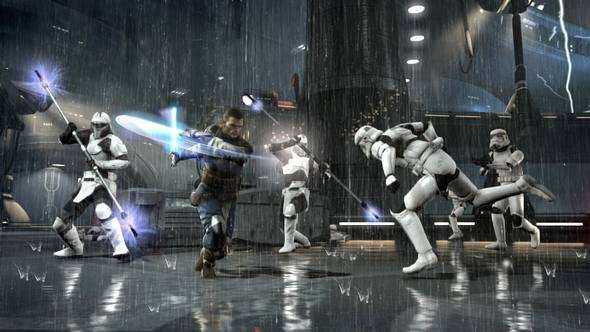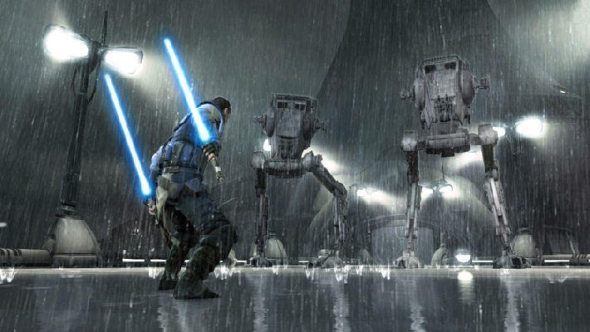
When it was released back in 2008, Star Wars: The Force Unleashed was met with stinging jabs from the critical community. Some of the game’s oft-mentioned flaws included repetitive combat, a poor camera, lame boss fights and a nearly broken targeting system. I did not share my compatriot’s problems with the game and actually found The Force Unleashed to be one of the better action-adventures of 2008.
But here we go again with Star Wars: The Force Unleashed II.
Platforms: PC, PS3, Xbox 360 (Version Played)
Publisher: LucasArts
Developer: LucasArts
Genre: Jedi Hack ‘n Slash Action
Release Date: October 26, 2010
ESRB Rating: Teen
The original Force Unleashed told a very self-contained story that seemed to leave no room for a sequel, what with Vader’s secret apprentice being killed at the end of it. But the Star Wars saga has always played fast and loose with the finality of death, and at the beginning of The Force Unleashed II, he lives, for he is a clone. Or is he? Starkiller is informed throughout the game that cloning a Jedi is impossible. This more personal saga of doubt and second chances is the driving force behind the game’s plot.
After a daring escape from a second death at the hands of Darth Vader, Starkiller whips across the galaxy, reuniting with everyone who knew him in his previous life. Rahm Kota, Juno Eclipse and PROXY will all play a role in Starkiller’s search for the truth throughout the game’s two planets and one capital ship (why yes, the game is rather short). But the game’s much vaunted cameo characters (Boba Fett! Yoda!) get roughly three lines apiece.
While the plot goes in new directions, The Force Unleashed II feels nearly identical to its predecessor. The developers at LucasArts changed relatively little about the game, though they did hand Starkiller a second Lightsaber and added the Jedi Mind Trick to his repertoire. Ultimately, the small number of new features and the game’s short length make it feel more like an expansion pack than a full-fledged sequel. However, if you loved the first game, the sequel offers up squadron after squadron of Stormtroopers to dispatch in creatively forceful ways.

The Lightsaber combat is once again quick and satisfying. As promised by producer Haden Blackman, LucasArts was able to push the envelope of the ESRB’s Teen rating and actually allowed Starkiller to decapitate enemies and amputate their limbs. It’s completely bloodless, but making a Trooper lose his head in battle adds the brutality of Lightsaber fighting that was missing from the first game.
Force Push and Force Lightning also return, although I believe LucasArts toned down the power of the Lightning in the sequel. When Starkiller first battled the Empire’s mechanized enforcers, Force Lightning seemed to be the great equalizer. This time around, Vader’s droids and walkers seem to stand their ground against Starkiller’s charge a lot better. The new kid on the block, Jedi Mind Trick, doesn’t fare much better as Stormtroopers rarely stay confused for long and tougher enemies are immune to its effects.
As much as things stay the same, LucasArts did listen to the complaints about one big piece of Starkiller’s world: the boss battles are no longer twitchy mashfests. And at no time does a Star Destroyer have to be pulled out of the sky by The Force (although I liked that part in the first game as well). The camera is also slightly improved, better following Starkiller as he zigs and zags across the game’s environments.
Sadly, the question of whether or not Starkiller is a clone isn’t answered during the single-player campaign. However, you can uncover the truth by unlocking the “Distant Thunder” videos in the game’s supplemental materials (as well as choosing the non-canon Dark Side ending). Once all the pieces fit together, you learn that Starkiller is not a clone. I can’t decide if withholding the answer to the game’s central mystery and hiding it in the bonus materials is a cheap copout or a brilliant way to encourage multiple playthroughs.

That replay is enhanced by a Challenge mode that is pretty satisfying. There are a total of ten Challenges and they include battling wave after wave of Stormtroopers, dodging a gauntlet of blaster fire, surviving endless volleys of missile fire from multiple AT-STs and dashing across a series of shifting platforms as quickly as possible. Even without the substantial payoff for a high score (the aforementioned “Distant Thunder” videos), I still played the Challenge mode over and over again until I developed calluses on my Lightsaber hand.
While the sequel doesn’t visit as many worlds as its predecessor, the graphics and audio are still very well done. The game’s environments (the rainy cities of Kamino, the Naboo-like casinos of Cato Nemoidia and the steel insides of the Alliance ship Salvation) look good, if a little simplistic. But once again, the audio is where this series shines. Everything is recreated perfectly, from the crack of a Lightsaber to the excellent vocal performances from all the leads. When it comes to the sounds of Star Wars, The Force Unleashed II does not disappoint.
It may sound cliche, but how much you enjoy Star Wars: The Force Unleashed II will depend entirely on how much you liked Starkiller’s first adventure. Flinging Stormtroopers into the distance and cutting a Lightsaber-fueled swath across the galaxy is as fun as ever. However, this sequel is extremely short and offers a story that never reaches the heights that the original did. However, it does set up three very interesting plot developments for a part three – if there ever is a part three. Ultimately, the game’s short length and the complete lack of any new features to justify the “II” in the title knock it down a peg. But Star Wars fans (and especially fans of The Force Unleashed) will want to give Star Wars: The Force Unleashed II a try (even though Yoda says there is no try).

Review Disclosure: A retail copy of Star Wars: The Force Unleashed II was purchased by Warp Zoned for the purposes of this review.







